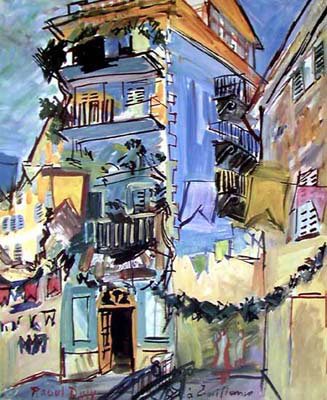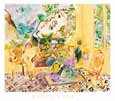Learn About Raoul Dufy in Art History, View His Art and Famous Paintings

Raoul Dufy, "May, in Nice", 1930
Raoul, 1877-1953, Dufy one of France’s famous artists in art history studied art under Corot and Boudin. His early art style was influenced by fauve color and the Impressionist painters when he painted one of his famous paintings “Le Port du Havre in 1906.

Dufy concentrated on color relationships, how color related to other colors in proximity and then to the art composition as a whole. Raoul Dufy, having no interest in detail maintained a group of similar objects were not to be rendered individually or accurately, but represented systematically. In his compositional system an artist must choose three colors, one representing the main color, a darker value of that color for shadow and the third color as light.
The artist must then systematize the proportion of light, shadow, and reflected light for balance. Light equaled three units, shadow two and reflected light one unit. This system allowed Dufy to represent the essence of an area without recording the local color as in the art painting “Stroll Nice”.

Raol Dufy used bright colors influenced by famous artists of Fauvism rarely using black except to enhance light. Color made an impression on Dufy more than form and active figures influencing the development of his artistic color system.
Lines were used by Raoul Dufy to trace edges of objects as an accent or enhancement, but did not totally define or enclose an object as in the painting”Bouquet d’arums”. Dufy’s figures and objects did not define or occupy space in the traditional three-dimensional art perspective. His flat linear quality represented the essence of a scene balanced by abstract areas and swatches of color not necessarily having anything to do with local color or relation to reality. Lines become thick and thin depending on emphasis and compositional balance.

Many of Raoul Dufy’s famous paintings have vertical bands of color zones or swatches of color. This is a method of rhythm and balance to extend his compositions infinitely across a flat picture plane if necessary. Each area can be different in subject matter and color then pulled together compositionally by strong or thick calligraphic lines and art forms.
This compositional style was well suited to decorative wall paintings where large spaces had to be filled. The style suited desire for boundless space allowing him to follow the rhythms of line and color not representative of true reality. Whereas traditional art painting attempted to create three-dimensional art space on a flat surface Dufy used his own compositional formula to express visual rhythms across a two-dimensional flat plane having limited depth.
In 1937 Raoul Dufy painted one of worlds largest mural paintings in art history The Celebration of Electricity” for the Electricity Pavilion in Paris, measuring 195 ft x 33 ft. Other famous artists of this period are Henri Matisse and Georges Braque.
To view the gallery of Raoul Dufy click here
Click on the graphics below to increase graphic sizes. At the same you time can also view an opportunity to purchase a poster or painting reproduction.














|